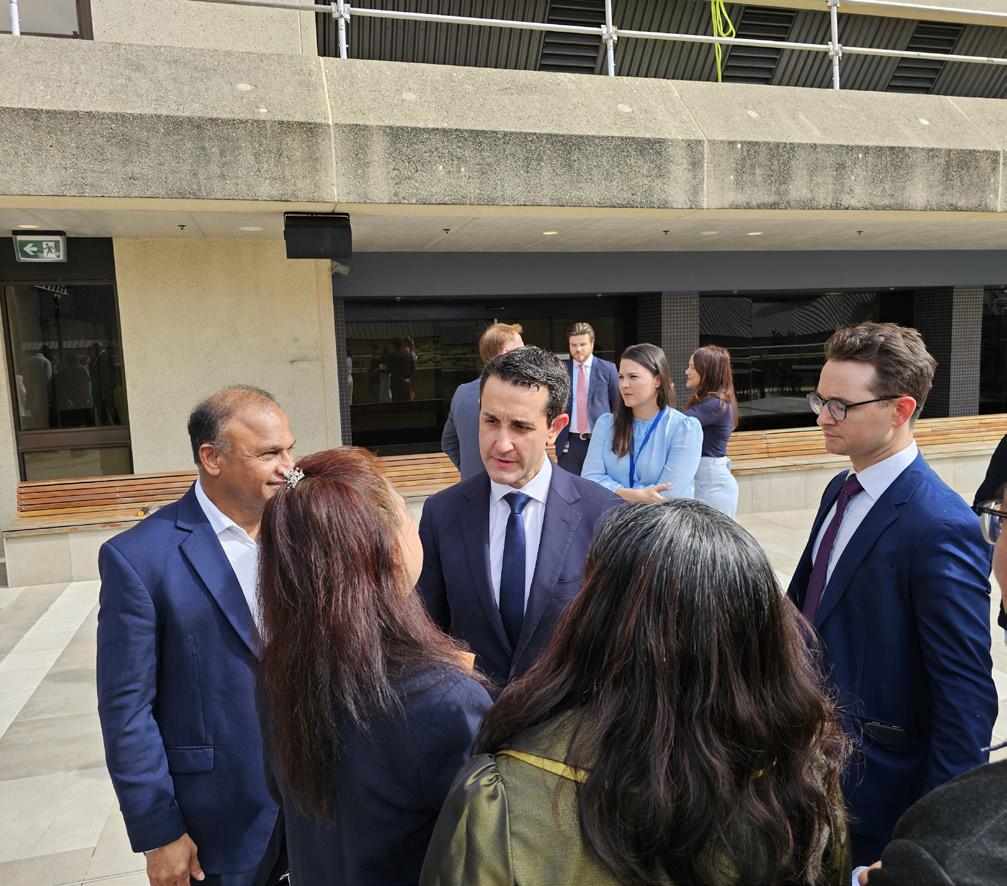
5 minute read
Crisafulli govt charts bold course with big-spending Queensland Budget
Brisbane, June 24 (Australia India News Newsdesk)
The Queensland government, under the leadership of premier David Crisafulli, has unveiled its first state budget for 2025–26, presenting a sweeping financial roadmap that significantly boosts spending on essential services and infrastructure—even as state debt is projected to climb beyond $205 billion by 2028–29.

Treasurer David Janetzki, delivering his maiden budget since the Liberal National Party’s electoral victory, outlined a strategy centred on funding healthcare, housing, law and order, transport, and Olympic infrastructure. He described the approach as steady and purposeful, focused on long-term investment over fiscal restraint, despite forecasting a deficit of $8.6 billion for the year.

Big gains for frontline sectors
A major portion of the budget is dedicated to expanding Queensland’s public sector workforce, with more than 6,000 new positions planned across hospitals, schools, police, and child protection services. Healthcare receives a historic boost of $33 billion in operational funding, including $18.5 billion set aside for the expansion and upgrade of hospitals and the construction of new medical facilities. This includes three new hospitals and over 2,600 new hospital beds across the state.

Law enforcement funding also receives a significant increase, with $2.4 billion for expanded correctional capacity in Townsville and Brisbane, $560 million for crime prevention and early intervention programs, and nearly $148 million for updated police equipment such as modern body-worn cameras and ballistic vests.

Housing market support for first home buyers
To address Queensland’s housing affordability crisis, the government has launched a new $165 million shared equity scheme, “Boost to Buy,” allowing first-time homebuyers to enter the property market with a deposit as low as 2%. Income eligibility thresholds are notably generous—up to $150,000 for singles and $225,000 for couples. The scheme is capped at 1,000 applicants.

Additional measures include scrapping stamp duty for new builds and extending the $30,000 First Home Owner Grant for another 12 months. A further $1 billion has been injected into the Residential Activation Fund to fast-track housing infrastructure across the state.
Major investment in roads and transport
A total of $41.7 billion has been committed to the Queensland Transport and Roads Investment Program, funding major infrastructure upgrades and expanding transport capacity. The Bruce Highway will receive a $9 billion upgrade, and a new $100 million regional road resilience program—Country Roads Connect—will focus on improving flood-prone routes.
Public transport fares will be permanently capped at 50% across the TransLink network, aimed at reducing travel costs for Queenslanders.
Olympic preparations accelerate
Ahead of the 2032 Brisbane Olympic and Paralympic Games, the government has committed $4.7 billion to sporting and logistical infrastructure. This includes $950 million for athlete villages and $847 million for regional sporting venues like Sunshine Coast Stadium and Logan Indoor Sports Centre.
Over $300 million is allocated to a dedicated Olympic Infrastructure Authority to oversee delivery.
Energy policy shifts away from hydro
Marking a distinct policy shift, the government has abandoned the large-scale Pioneer-Burdekin hydroelectric project and scaled back the Borumba battery program. Instead, it will support smaller pumped hydro schemes and invest $1.6 billion in a new five-year Electricity Maintenance Guarantee to ensure energy reliability and retain base-load power from coal and gas.
A $2.4 billion investment will also go into the CopperString transmission line connecting Townsville and Mount Isa. For renters, the “Supercharged Solar” program will offer landlords rebates up to $3,500 for installing solar panels, with the goal of reducing power bills for tenants.
Families, education and community sport
Cost-of-living support measures include making permanent the $100 Back to School payment for essential supplies and continuing $200 PlayOn! vouchers for sports and extracurricular activities.
Education receives a boost with the commitment to build 15 new schools and specialist campuses across Queensland, including new primary, secondary, and youth justice facilities.
An additional $500 million will fund upgrades to more than 100 local sports clubs as part of Olympic legacy programs.
Fiscal challenges and political debate
Despite bold spending commitments, the budget forecasts rising debt and continued deficits. Gross debt is expected to reach $205.7 billion by 2028–29, down from Labor’s earlier projection of $252 billion.
Treasurer Janetzki blamed a $2.3 billion drop in GST revenue from the Commonwealth for a significant portion of the current deficit, calling it a major setback to state finances.
While the government insists this budget sets a clear path toward financial recovery, critics are unconvinced. Opposition finance spokesperson Shannon Fentiman said the budget delays hard decisions and creates long-term risks, describing it as driven more by politics than sound economics.
Unions prepare for wage battles
The budget forecasts public sector wage growth and staff costs will be capped at an average of 3.5% per year. However, unions are bracing for tough negotiations. Nurses are already protesting the government’s offer of an 8% wage rise over three years, claiming it fails to deliver on campaign promises. Similar negotiations for police, teachers, and firefighters are expected soon.
Revenue pressures from mining sector
The budget also signals declining returns from coal royalties, with Treasurer Janetzki accusing the former government of relying too heavily on temporary windfalls. With global prices falling, revenue from coal is expected to shrink considerably, prompting calls for a review of royalty structures. With its first budget, the Crisafulli government has outlined an ambitious and high-investment vision for Queensland— emphasising services and infrastructure over austerity. However, its long-term success will depend on how effectively it manages ballooning debt, public sector demands, and the delivery of Olympic and housing promises.









